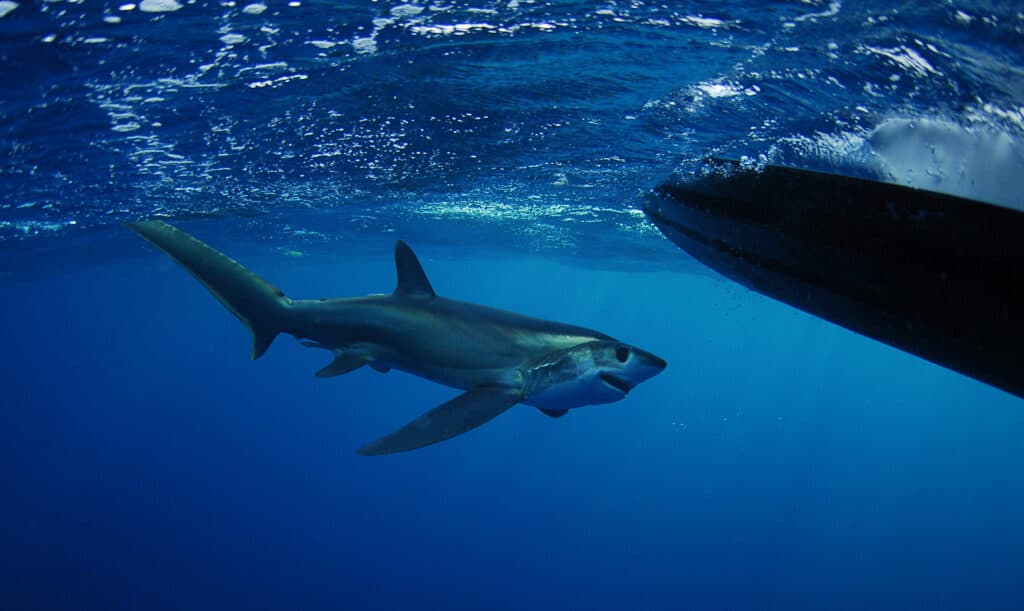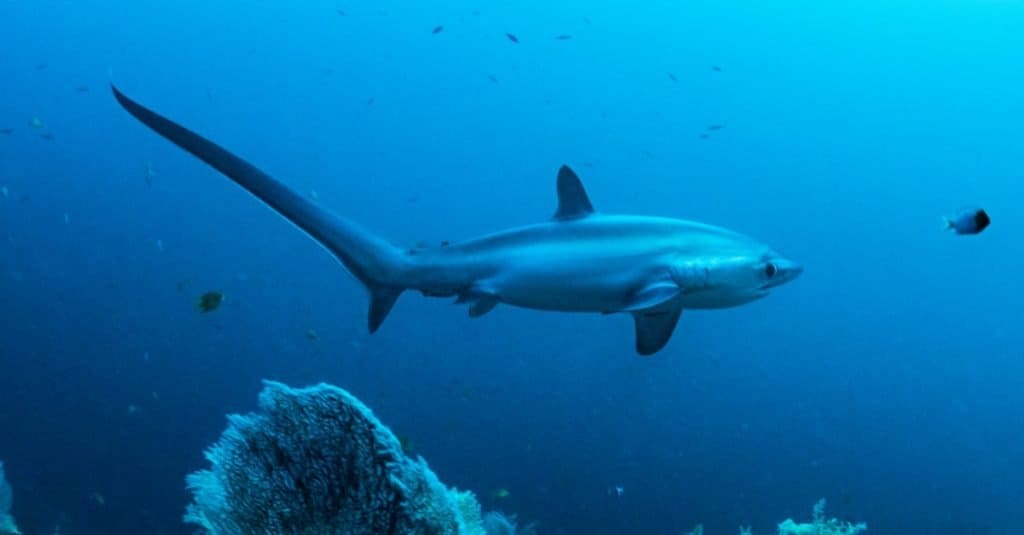Nicknamed “The Fox of the Ocean,” thresher sharks are large sea creatures found in all temperate and tropical oceans everywhere in the world. Their unique name is derived from the Greek word ἀλώπηξ, alṓpēx meaning fox, based on their distinctive, sickle-like or thresher-like tail, which makes up almost one-half of their total length.
Thresher sharks belong to the family Alopiidae, which includes three extant shark species, all within the genus Alopias: Common thresher (Alopias vulpinus), Pelagic thresher (Alopias pelagicus), and Bigeye thresher (Alopias superciliosus). In this article, you’ll discover how big thresher sharks can get and the largest thresher shark on record.
How to Identify Thresher Sharks

The thresher shark’s tail can be as long as its whole body.
©FtLaud/Shutterstock.com
Thresher sharks are aptly named for their exceptionally long, thresher-like tails or caudal fins, which can be as long as the whole body of the shark itself. The bulk of their size comes from their tails which make up half their total body length! Their head is short and cone-shaped, with small mouths and teeth ranging in size from small to large. A thresher shark’s teeth are curved, smooth-edged, and extremely sharp. They are much pointier and triangular in the common and bigeye threshers than in the pelagic threshers. These sharks have small dorsal fins and large pectoral fins.
Thresher sharks are slender, with skin color ranging from brownish to bluish or purple-gray dorsally and lighter shades on their ventral side. Colorations differ depending on the species as Common threshers are dark green, Pelagic threshers are blue, and Bigeye threshers are brown. So, the three thresher shark species can be differentiated by the main color of the dorsal surface of the body. Meanwhile, water conditions such as lighting and clarity can affect how any shark appears to anyone observing.
The Thresher Shark’s Range and Habitat
The range of thresher sharks varies according to species. Of all three species, common thresher sharks are distributed along the continental shelves of North America and Asia of the North Pacific. Still, they are rare in the Central and Western Pacific. The other two species, Bigeye and Pelagic thresher sharks, are more common in the warmer waters of the Central and Western Pacific.
Generally, thresher sharks are found in tropical and cold sea waters worldwide. Although they are occasionally seen in shallow coastal waters, thresher sharks are primarily pelagic. They prefer the open ocean and tend to be more prevalent in water 1,600 feet (500 meters) and less. Common thresher species have a preference for coastal waters over continental shelves.
What Is the Largest Thresher Shark on Record?

The largest thresher shark on record was estimated to be 32 feet long.
©Shane Gross/Shutterstock.com
The Common Thresher is by far the largest of the three thresher sharks, reaching a total length of 20 feet (6.1 meters) and weighing over 1,100 pounds (500 kilograms). The Bigeye Thresher is the next largest, reaching a length of 16 feet (4.9 meters). At just 10 feet (3 meters), the Pelagic thresher is the smallest species. The largest thresher shark on record was estimated at 32 feet, caught by fisherman Roger Nowell near the Lands End peninsula off the coast of Cornwall. The giant thresher shark weighed an enormous 1,250 pounds. Unfortunately, according to the media, it didn’t live for long and was auctioned off in 2007.
Another giant thresher shark on record in the Florida Museum of Natural History is a thresher shark estimated at 24.9 feet (7.6 meters) long.

What Do Thresher Sharks Eat?

Thresher sharks eat pelagic schooling fish, such as mackerel, herring, and bluefish.
©bearacreative/Shutterstock.com
Thresher sharks are active predators mainly feeding on pelagic schooling fish such as mackerel, herring, bluefish, and juvenile tuna. Threshers also eat mollusks such as squid and cuttlefish, as well as crustaceans and seabirds. As described earlier, they stun prey using their elongated tail as a weapon. Thresher sharks are primarily preyed on by larger shark species and orcas.
How Do Thresher Sharks Hunt?
Thresher sharks are solitary creatures, though some species occasionally hunt in a group of two to three. They are one of the few sharks known to fully jump out of the water using their elongated tail to propel themselves like dolphins — a behavior called breaching. It is known that thresher sharks swipe their enormous tails like a whip when hunting to stun smaller prey, typically schooling fish, and making them easier to catch. The elongated tail ‘whips’ the water and smacks fish directly with the powerful waves generated by the swipes.
Conservation Status of the Thresher Shark
Thresher sharks are recognized as prized sport fish in the United States and South Africa. Common thresher sharks, the largest thresher shark species, are the target of a popular recreational fishery located off Baja, Mexico. Thresher sharks are also victims of the trade in shark meat and the use of their liver for shark liver oil, skin for leather, and fins for shark-fin soup. Because of this, thresher sharks are highly vulnerable to overfishing.
Two species of thresher sharks (the common and the bigeye thresher) are currently listed as vulnerable to extinction by the IUCN, while the pelagic thresher shark is endangered. Because they are popular as sport fish and hunted for their meat, livers, skin, and fins, there has been a significant reduction in the population of thresher sharks.
Are Thresher Sharks Dangerous?
There have been no reported cases of thresher shark attacks in history, which proves that this species is not a threat to humans. They do not consume large prey, so there is little chance of them confusing people with their natural prey, as in most shark bites. Based on this fact, they are not considered dangerous to humans.
The photo featured at the top of this post is © FtLaud/Shutterstock.com
Thank you for reading! Have some feedback for us? Contact the AZ Animals editorial team.






